Your RV’s water heater supplies hot water to sinks and showers inside (and potentially outside) your RV. If you want a hot shower after a day of outdoor adventures, you’ll need your water heater to function efficiently and effectively.
This article will help you understand, maintain, and troubleshoot RV water heaters.
Types of RV Hot Water Heaters
Click to view slideshow.
Most modern RVs are either equipped with a gas/electric DSI water heater, a tankless water heater, or a pilot model. Pilot models require a standing pilot flame that must be extinguished before moving your RV.
DSI water heaters offer a spark igniter that initiates when you turn on the control switch for the gas mode inside your RV. Most DSI electric and gas water heaters offer a six or ten-gallon water storage tank capacity.
DSI stands for ‘direct spark ignition.’
Suburban and Dometic (formerly Atwood) are two of the most common brands for DSI gas/electric RV water heaters. Here’s an overview of each:
Dometic 6-Gallon Water Heater Overview
Suburban SW6D Water Heater Overview
Tankless water heaters are becoming increasingly common on new RVs. Some of the leading brands include Girard, RecPro by Fogatti, Camplux, Lippert, Suburban, Truma Aqua-Go, and PrecisionTemp.
Also known as “instantaneous” or “on-demand” water heaters, they heat water as it passes through a coil with heat applied over it. Although often used, the term “instantaneous” can be misleading, as they still have a 20-30 second delay to get the water heated and through the pipes to the faucet.
One more model is an extended-range water heater or EXT. In these models, the temperature control is set at 40℉ higher than in standard models. A mixing valve on the back blends cold water with the superheated water from the tank to deliver about 20% more hot water than the tank is rated for.
For example, an EXT water heater with a 10-gallon tank can provide up to 12 gallons of hot water. These models operate like others but require special attention when winterizing your RV.
Where to Find Your RV Water Heater
The location of your RV’s water heater depends on the manufacturer. Most place them on the off-camp side of your RV, opposite the main entry door. However, your water heater’s location can be towards the front or back of your RV if you have a rear kitchen or front kitchen floorplan.
Here’s an example of what your water heater’s exterior access panel may look like:
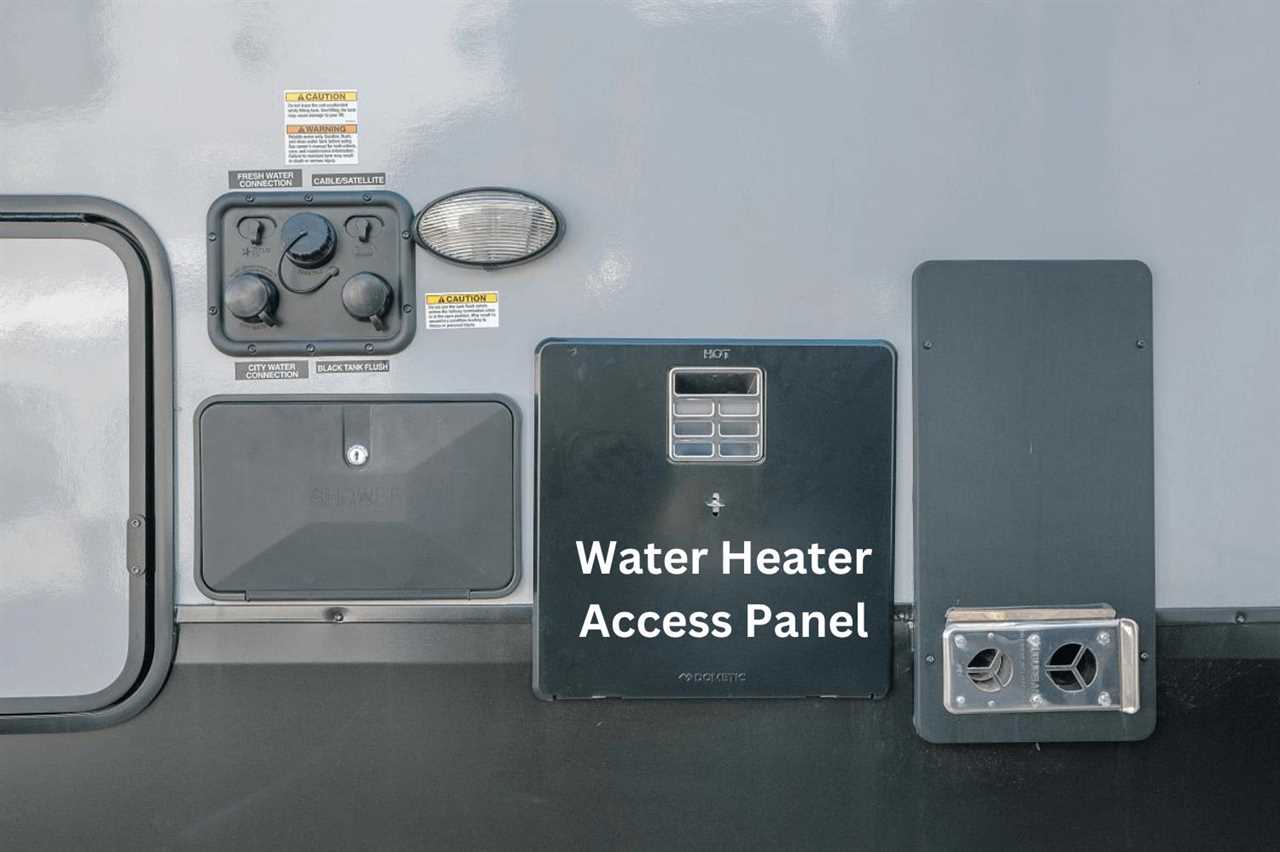
Photo by Camping World
And here’s an example of a water heater tank and plumbing lines from the inside of an RV:
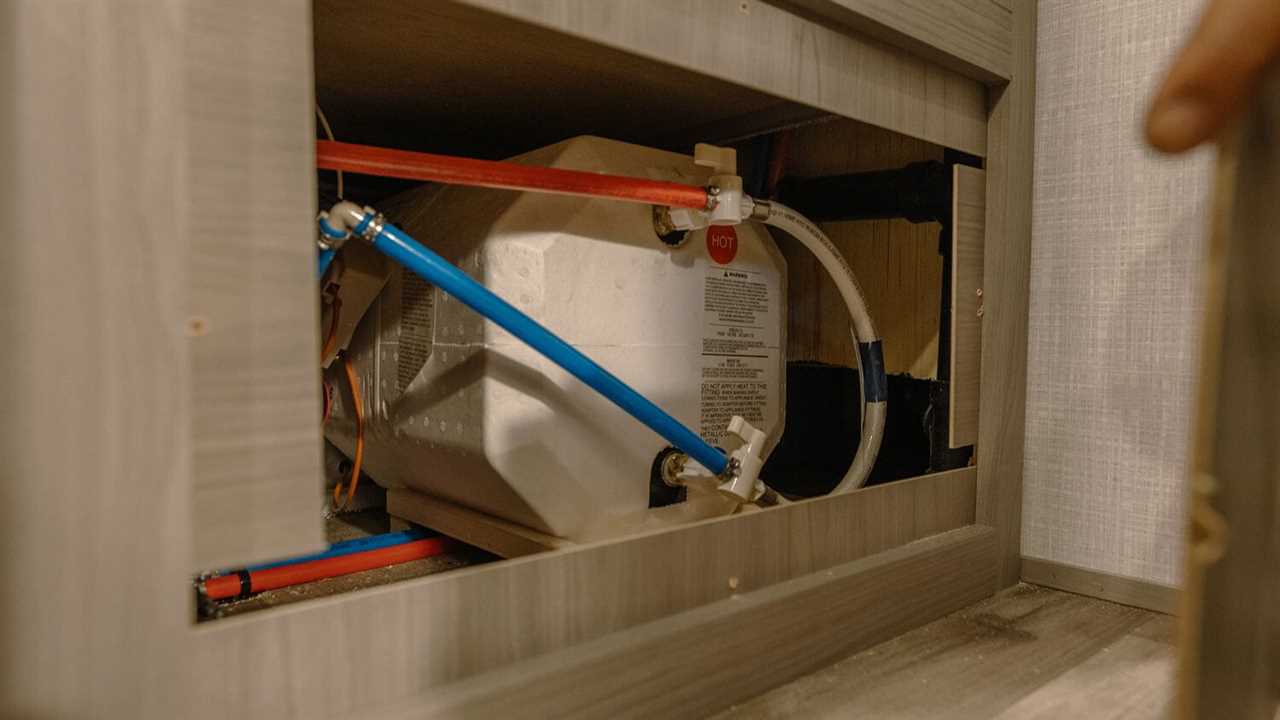
Photo by Camping World
How Do RV Water Heaters Work?
Because DSI and tankless models are now common on many RVs, let’s cover the basic operations of each:
How Do DSI Water Heaters Work?
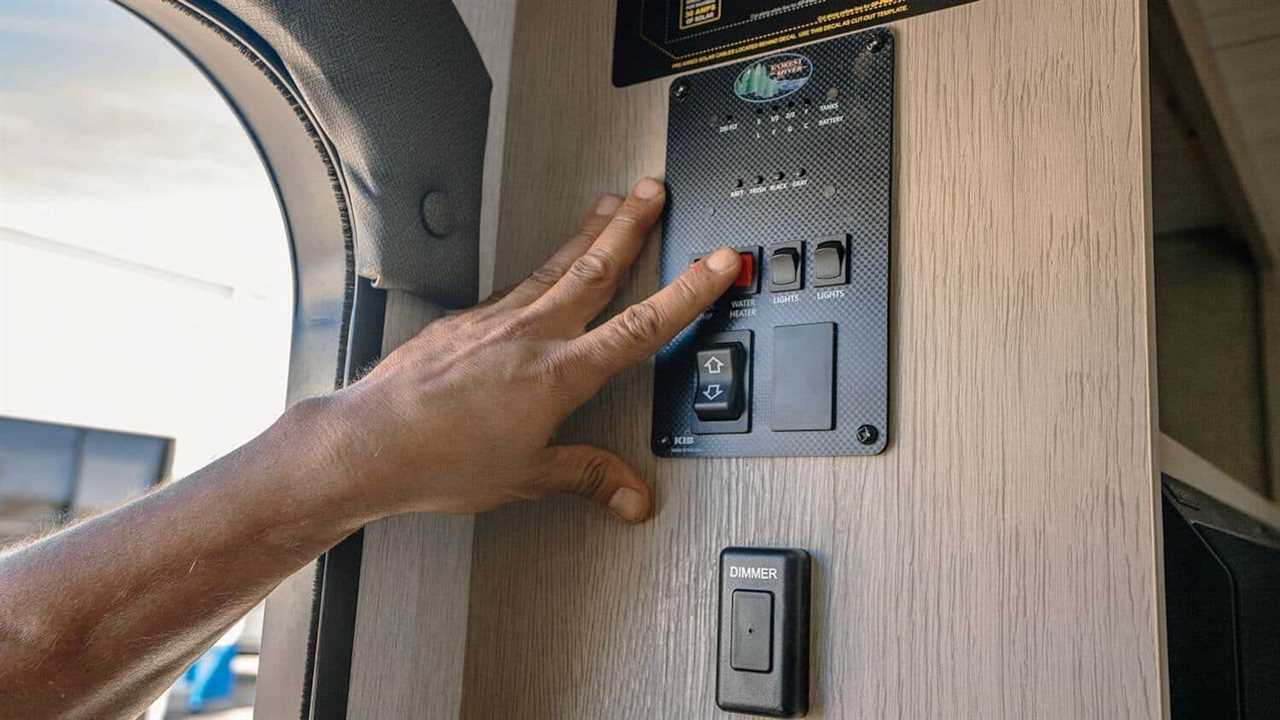
Photo by Camping World
When you connect your RV to city water or turn on the water pump after filling your fresh water tank, your water heater’s tank will be filled (so long as it’s not bypassed). Ensuring the tank is full is the first step in operating any water heater before turning the water heater on with your RV’s control panel.
If you have a gas/electric model, you can choose to use propane or the electric element to heat water in the tank. You can also employ both for quick hot water recovery. Both modes require 12-volt DC (VDC) power.
Propane is the primary heating source for DSI models. The propane is burned at the end of the burner tube, and the flame enters the flue tube. Heat and exhaust gasses are carried through to an exhaust vent at the top of the water heater.
Here’s the sequence of operation when your water heater uses propane:
- The propane control switch is turned on.
- 12 VDC goes through the thermostat – normally a closed switch.
- The thermostat demands heat and contacts close, opening the propane valve.
- The spark ignites the gas in the burner tube.
- When a set temperature is attained (usually 140℉), the thermostat’s electrical contacts open, closing the gas valve.
In the electric mode, sufficient 120-volt AC (VAC) power is required to heat the electric element. This mode will only be an option when plugging into shore power or using an RV generator.
Technician Tip: The requirements for voltages, amperages, or wattages can be found on the data plate or in your owner’s manual.
Here’s the sequence of operation when your water heater uses electricity:
- The electric switch is turned on.
- 120 VAC goes through the thermostat – normally a closed switch.
- The thermostat demands heat and contacts close.
- 120 VAC goes through the ECO (energy cut-off) switch, normally closed.
- 120 VAC goes to the heating element and heats water in the tank.
- When the set temperature is attained, the thermostat’s electrical contacts open, removing power from the electric heating element.
Technician Tip: Steps 2 and 4 may be reversed on certain models.
How Do Tankless Water Heaters Work?
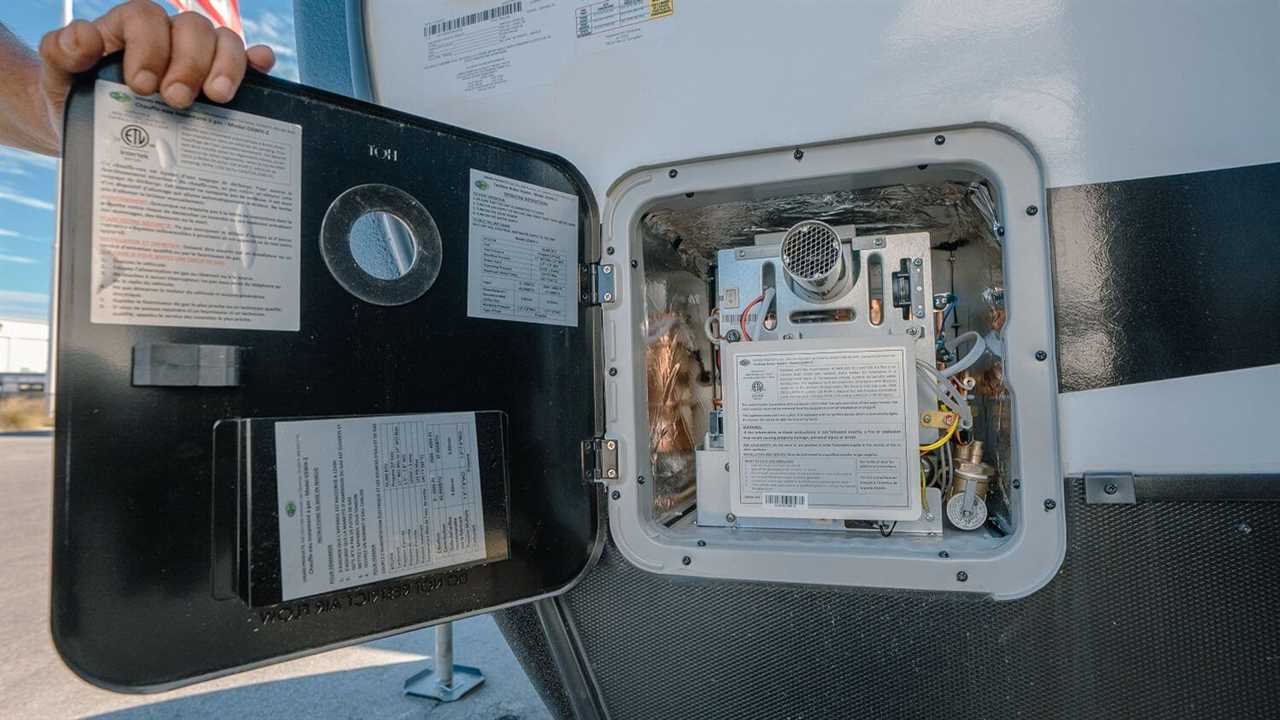
Photo by Camping World
Also known as on-demand, tankless RV water heaters provide instantaneous hot water. When you open a hot water fixture, cold water runs through a heat exchanger that’s heated by LP gas.
The burners are only lit when a hot water faucet is opened. When this happens, a valve is activated by the water flow, closing a circuit that opens the propane valve. The burners ignite and heat the water while it’s flowing. When the faucet is turned off, the switch closed by the opening of the valve will open, shutting off power to the water heater burner.
Most tankless water heaters use a copper coil because it provides the maximum heat transfer properties for efficiency. Multiple burners* apply heat along the coil to reduce recovery time to virtually zero, as there’s no water storage tank to be heated.
*Some tankless models boast a single, large burner with a powered combustion air blower.
On-demand water heaters do not have a thermostat because there’s no water storage tank. They are designed with redundant ECO switches that monitor the heat as water moves through the heat exchanger. These ECO switches shut off the burner if the water temperature gets too high and back on when the temperature drops back into the set range.
Learn more about what to look for in a tankless water heater.
How to Operate an RV Water Heater
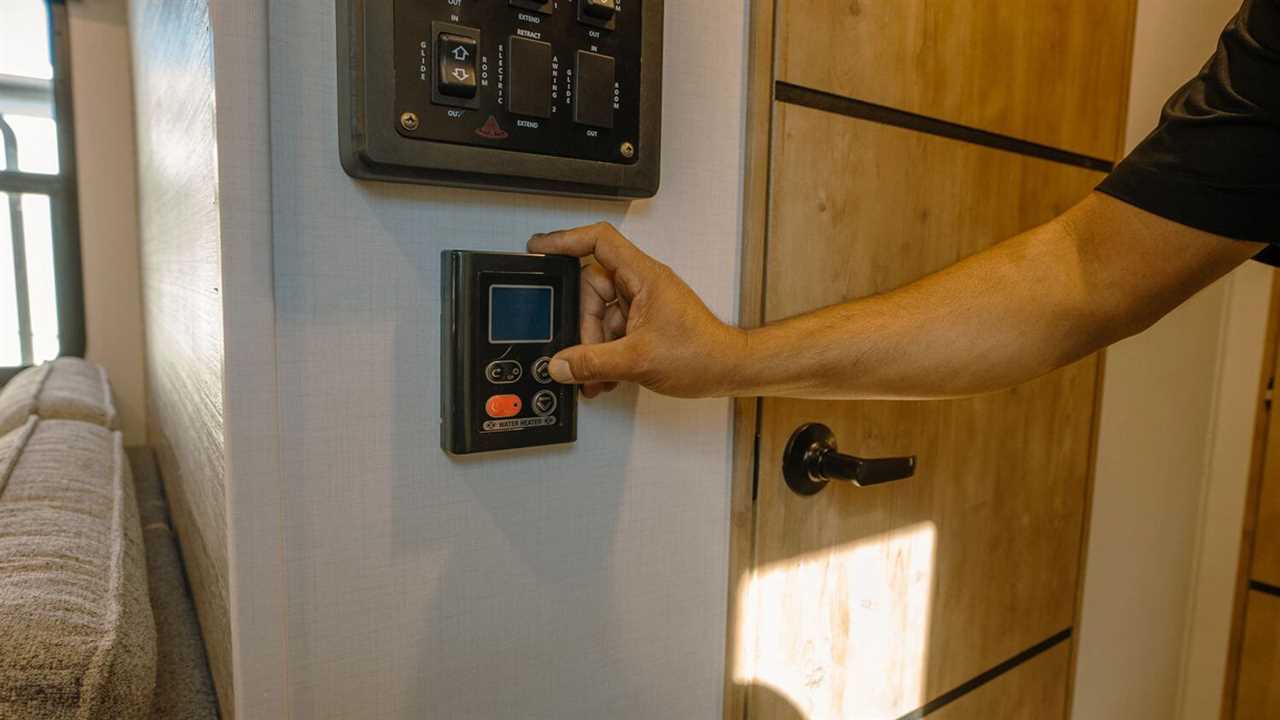
Photo by Camping World
As with all RV appliances, your owner’s manual is the best place to start when looking for operating instructions. This is because manufacturers differ based on the design of their water heater models.
That said, most gas/electric DSI water heaters have similar operating procedures. You’ll have the option to heat the tank using LP gas, 120-volt AC, or both in some cases. Using both allows for quick recovery.
Quick recovery = faster heating of water in the tank.
To use a DSI water heater, go to your RV’s control panel and turn on the switch to the gas or electric mode – or both. For gas mode, you should hear the pilot ignite within 6-8 seconds.
To use a tankless water heater, open a hot faucet and wait for the water to run hot. The downside of some on-demand models is that you’ll waste more water as you wait for it to heat up, but newer models heat more efficiently and reduce water consumption.
Many RV fixtures are low flow to conserve water. Typically, a flow rate of 0.8 gallons per minute (GPM) is required to close the switch that turns on the tankless water heater’s burner.
Technician Tip: If a unit has trouble activating the water heater from one or more faucets, the flow restriction disc in the aerator may need to be removed. This will increase the flow, thereby improving hot water reliability. If the system has always performed well and one or more faucets suddenly no longer turn on the water heater, the aerator may need to be disassembled and cleaned.
How to Drain an RV Water Heater
Subscribe to the Camping World YouTube channel and never miss a service and maintenance video.
Your RV’s water heater should be drained and serviced every six months to prevent clogging your plumbing lines, faucets, and showerheads. It’s the perfect time to inspect and replace your anode rod, if necessary, while you’re at it.
It’s also important to drain aluminum water heaters if they aren’t used for a period of two weeks or longer. This prevents electrolysis and the build-up of bacteria and potentially harmful gasses within the water heater.
Because there’s so much variety in water heater models installed in RVs, your owner’s manual is your best resource for specific service and maintenance procedures. This process covers standard DSI water heaters, not tankless water heaters.
Be mindful of where you’re draining water. Most water heaters hold six or 10 gallons of water, so collecting water in two 5-gallon buckets will allow you to transport and empty into an RV dump station if you can’t drain water directly onto the ground where your RV is parked.
This is a matter of courtesy and respect for the site. Water from the water heater is potable and harmless, but you may leave considerable mineral sand behind when flushing sediments from your tank. That sand is also harmless but creates a mess that’s difficult to clean.
Here’s the step-by-step process for draining your RV’s water heater:
- Turn off the power to the water heater and open the hot water faucets inside your RV to let them run until the water turns cold, allowing 2-3 minutes for the tank to cool if it has recently been heated. The water in your tank is heated to 140℉, which can cause burns if poured directly from the drain. Running water in the sink until it’s cool to the touch is the safest method before proceeding.
- Turn off the power to the water pump and disconnect it from city water.
- Open the pressure relief valve until the water is no longer draining.
- Remove the anode rod or drain plug and let the water drain until none remains in the water heater tank.
- Close the pressure relief valve and replace your anode rod or plug once drained. Use Teflon tape to wrap the threads before replacing your drain plug or anode rod.
If you’re seeing a lot of calcium buildup from your water heater, it may be a good idea to fill and drain it a second time.
Technician Tip: Camping World also sells a water heater tank rinser with a valve that attaches to a garden hose. That tube inserts into the drain bung and allows you to accurately direct the steam of water around the inside of your water heater tank to dislodge sediment and flush it out the drain.
How to Change your Anode Rod
Smelly and discolored hot water is a tell-tale sign of a bad anode rod. Most water heater anode rods last up to five years. When corroded, your anode rod no longer protects the lining of your hot water heater tank.
An anode rod is a metal rod that extends into your tank’s interior to prevent corrosion of the tank.
Usually made of magnesium or aluminum, an anode rod attracts iron, limestone, and other minerals to prevent them from corroding the inside of the tank.
Most manufacturers recommend inspecting your anode rod annually and replacing it when it’s less than 75% of its original size.
Technician Tip: Water heaters with a steel tank require an anode rod that essentially sacrifices itself by attracting corrosive particles and keeping them from corroding the tank’s lining. Aluminum water heater tanks do not require an anode rod. Instead, they have an anodic coating applied to the inside of the tank when manufactured.
Here’s how to replace your anode rod:
- Obtain the proper OEM (original equipment manufacturer) replacement as your water heater’s manual recommends.
- Follow steps 1-5 above.
- Inspect your current anode rod.
- If corroded, install a new anode rod and dispose of the old one. Use a few wraps of Teflon tape on the threads of the anode rod to prevent leaks. The tape should say “for potable water” on the packaging.
- If not corroded, add Teflon tape, reinstall, and inspect it again the next time you drain your water heater.
- Ensure your pressure relief valve is closed before powering up your water heater again.
Shop water heater parts and accessories for a new anode rod or other replacement parts.
Technician Tip: Always use OEM replacement parts as specified by the manufacturer.
Why is My Hot Water Heater Not Working?
Here are some of the most common problems you’ll experience with your RV’s water heater:
- Insufficient power. Did you turn your water heater on? Have you checked your battery’s voltage? Have you checked your circuit breaker?
- Insufficient propane. Are your propane containers empty? Are the valves on top open to supply propane to your appliances?
- Time delay. Have you purged cold water from the lines? Did you wait long enough for the water in the tank to be heated?
- Overuse. Did you use up all the hot water in your tank? Do you need to wait for it to refill and reheat?
- No flame. Did you hear the spark ignite? Can you see a flame in the burner tube when you open the exterior access panel?
- No water in the tank. Is your T&P valve hot? Have you bypassed your tank and forgotten to switch that valve back for normal operation?
- Hot from cold. Are your hot and cold water lines reversed? Do you get hot water when you open what should be the handle for the cold water supply on your fixture?
- Bad mixing valve. Is the problem unique to one sink or fixture? Do you get hot water from another fixture, such as in the bathroom or shower?
If you’re stuck with your water heater repair needs or uncomfortable troubleshooting, schedule a service appointment to have it inspected by a certified RV technician.
What questions do you have about using and maintaining your RV water heater? Let us know in the comments below.
By: Tucker Ballister
Title: How Do RV Water Heaters Work?
Sourced From: blog.campingworld.com/using-your-rv/how-do-rv-water-heaters-work/
Published Date: Mon, 13 Mar 2023 14:00:03 +0000
---------------------------------------------
 CampingSurvivalistHuntingFishingExploringHikingPrivacy PolicyTerms And Conditions
CampingSurvivalistHuntingFishingExploringHikingPrivacy PolicyTerms And Conditions
